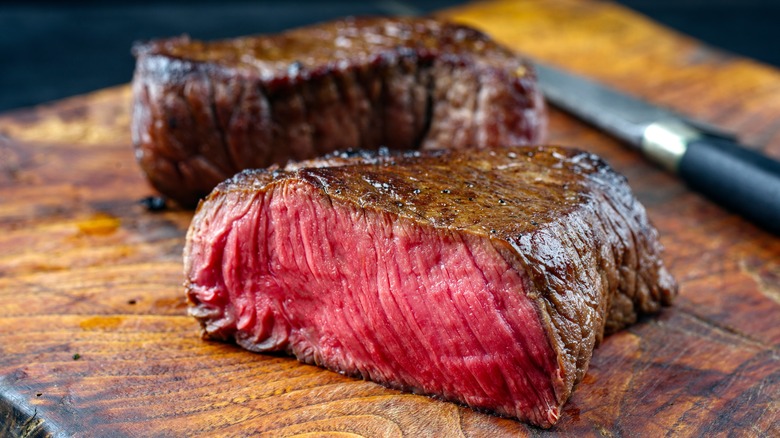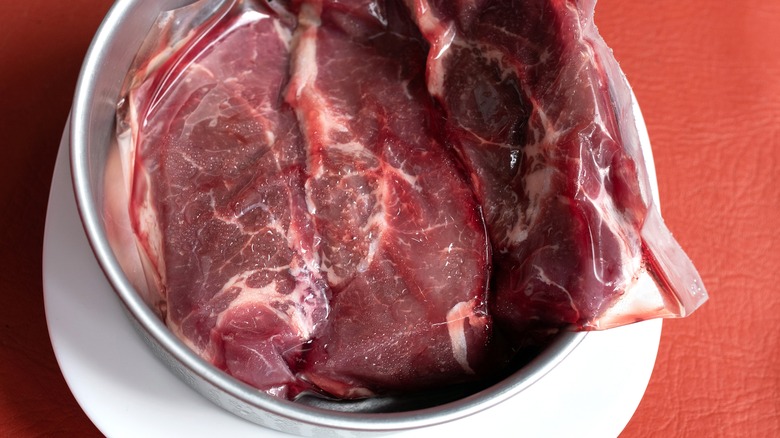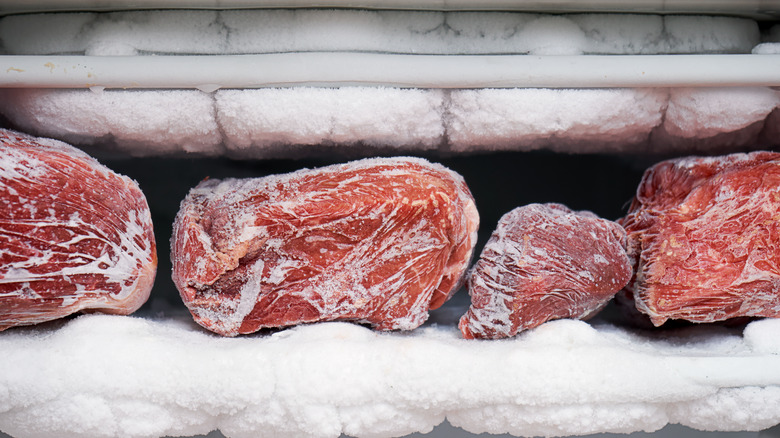What To Do If You Need To Thaw Frozen Steak Fast
It's five o'clock on a weekday, and you had your heart set on steak for dinner, only to find out someone forgot to take it out of the freezer a day or two ago. It's almost dinner time and there's no getting around it: you're going to have to find some way to cut down thawing time dramatically.
It turns out that there are straightforward ways to quickly thaw meat. Even better, the steak still tastes great, assuming it was properly wrapped prior to freezing (sometimes freezing steaks unwrapped first, then wrapping well for storage works best). On top of that, there are two quick-thaw (or quicker-thaw) methods that the USDA says are safe, so you have choices. What the USDA recommends against is thawing meat on the counter or running it under hot water. The challenge with both methods is that while the steak's interior may be frozen solid, the outer layers have probably warmed above 40 degree Fahrenheit creating the perfect breeding ground for harmful bacteria. Use the time the steaks are thawing to prep other ingredients and side dishes. That way not only are you not losing time on a task you'd hoped was already done, but dinner will be ready on time and complete.
Two methods for thawing steak quickly
One of the best ways to defrost raw meat (or any frozen food) is slowly, in the refrigerator. Take it straight out of the freezer, set the package on a small plate (to catch moisture), and let it rest for a day or two in the fridge until fully or near-fully thawed. But if you're crunched for time, consider one of two approved options.
First, you can thaw the meat in a bowl of cold water. Place each steak inside a sealed, waterproof plastic bag (freezer bags are sturdiest), squeezing out any air before sealing. Submerge in a bowl or in a sink filled with cold tap water. Change the water out every half hour (or run a slow drip from the faucet) to speed up the process. Make certain the package is sealed to avoid letting either water or airborne bacteria in while the steak soaks. Small cuts should be ready in an hour, larger ones in about three.
Alternatively, that "thaw" setting on the microwave actually works. And it only takes ten minutes or so. Remove the meat from its package and set it on a microwave-safe plate or bowl. Enter the weight or cut of meat (depending on the microwave's settings) and follow instructions for flipping the meat throughout the process. The important thing here is you'll need to cook the meat immediately after you thaw it, because some parts will exceed that 40 degree mark (often by a lot). But you can fry it, bake it, or yes, microwave it as desired.
It turns out you can cook frozen steak
If time is truly of the essence, the USDA says cooking straight from the freezer is totally fine. Yes, you heard that right. However, there are some tricks. You're going to want to fry the meat at high heat in a sturdy pan with some oil. Wipe off any ice crystals to avoid splatters. Don't worry about seasoning the meat until it's cooked a bit (salt and pepper won't stick to the frozen brick you're starting with). Expect to cook each side about 50% longer than you normally would (so about seven or eight minutes per side if it's usually five).
This is where freezing unwrapped steaks come in handy, because you can freeze them perfectly flat on a baking sheet. This is the secret to getting that perfect crispy crust on frozen steaks to happen evenly across the entire surface. In fact, this method is pretty perfect for getting a glorious Maillard reaction and a bright pink interior on thick cuts. A quality meat thermometer helps ensure you're hitting the magic 130-135 degree temperature inside. Try and avoid flipping the meat more than once, though you may want to use tongs to sear the sides. If you like basting your steak with butter, wait until the steak is near fully cooked, remove it from the pan, and heat up the butter. Return the steak to the pan for another minute or two of basting. And of course, let the meat rest for five minutes before serving.


